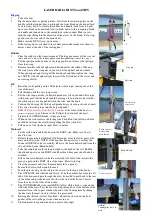
17
Chapter 5
Operation
5.1
Manual Operation
The Filter Flipper offers a fully featured motion control capability including Transit
Time and I/O Configuration. When the unit is connected to the PC, these parameters
are automatically set to a llow “out of the box” operation with no further “tuning”
required. However, further adjustment is possible via the APT Server software - see
Chapter 6.
The flip action is activated manually by a button on the top of the unit, or by handset
supplied.
The unit features two SMA connectors, marked DIG IO 1 & DIG IO 2. A TTL trigger
input (configured in the Settings panel - see Section 6.3.) causes the flipper to toggle
to the next state. If the user button or another trigger signal comes in before the end
of the move then the flipper will ignore the demand until the current move is complete.
5.2
PC-Base Operation
5.2.1
Introduction
The following brief tutorial guides the user thro ugh a typical series o f moves and
parameter adjustments performed using the PC based APT software. It assumes that
the unit is el ectrically connected as described in Section 4.2. an d that the APT
Software is already installed - see Section 4.1.
Warning
When the unit is powered up, do not move the flipper arm by hand.
Notes
If power is removed, the unit may remain in the same position, or due to
gravity, may move to the lower limit.
The external DIG IO connectors can be configured as input or output to accept
various different signal types. A particular IO configuration can be ‘persisted
(saved) within the unit for future use when operating in Stand Alone mode
without a control PC - see Section 6.3. for more information.
Warning
As the unit is raised and lowered, items can become trapped in the
mechanism. During operation, keep fingers, clothing and tools away from
any moving parts.
When the unit is powered up, do not move the flipper arm by hand.
















































